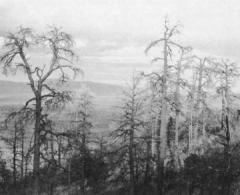
This Article From Issue
January-February 2012
Volume 100, Number 1
Page 68
DOI: 10.1511/2012.94.68
DEEP HISTORY: The Architecture of Past and Present. Andrew Shryock and Daniel Lord Smail, with Timothy Earle, Gillian Feeley-Harnik, Felipe Fernández-Armesto, Clive Gamble, April McMahon, John C. Mitani, Hendrik Poinar, Mary C. Stiner and Thomas R. Trautmann. xviii + 342 pp. University of California Press, 2011. $29.95.
Deep History is the product of a challenging project conceived by two academics “of the tribe of humanists and social scientists.” Anthropologist Andrew Shryock and medieval historian Daniel Lord Smail are deeply impressed by the growing body of evidence we now have for the deep human past, from the prehistoric period—before the origins of writing—and indeed from the deep prehistoric period, before the agricultural revolution, which brought with it farming and the settled way of life. They and the varied specialists they have brought together offer some fresh and valuable insights into the human condition of today and yesterday. But I have a reservation, which grew as I read and reread this intriguing book. By stressing the very remote past of the hunter-gatherers of the Paleolithic era and then leaping to the modernity of today’s world, without much emphasis on the intervening ancient world of Greece and Rome or the earlier civilizations of Sumer and Egypt (or indeed of the Incas and the Aztecs), do the authors risk recreating the Noble Savage? By underplaying the ancient civilizations, from Shang China to the Olmec of Mesoamerica, are they perhaps jumping from savagery to modernity without having sufficiently considered the mediating effects of barbarism or of early civilization?

Deep History asks “how we might develop a new architecture for human history”—indeed a radical project. “This is a book about the deep history of humankind,” say the authors, “a domain of inquiry that extends millions of years into the past. Although it might seem the perfect subject matter for historians, this vast time-space was left out of most historical writing almost as soon as it was discovered.” The book starts from this observation: “Humans have always been interested in their origins, but the deep past, as typically understood by modern historians, is never deeper than antiquity and is sometimes positioned in an even more recent era.”
Emboldened by recent research into human origins, Smail and Shryock have assembled a group of nine archaeologists, anthropologists and culture historians. In 10 multiauthored chapters they survey the origins of humankind from our ancestors of 6 million years ago, through the out-of-Africa expansion of our species some 50,000 years ago, and on to the various independent origins of agriculture and the foundations of modern society. The treatment is thematic, with chapters titled “Body,” “Energy and Ecosystems,” “Language,” “Food,” “Deep Kinship,” “Migration,” “Goods” and “Scale.” All of the chapters read well. “Food,” by historian Felipe Fernández-Armesto and Smail, is a refreshing overview of cooking and eating over the millennia. “Deep Kinship,” by historian and anthropologist Thomas R. Trautmann, anthropologist Gillian Feeley-Harnik and primate behavioral ecologist John C. Mitani, has little archaeology yet offers real insights into the way humans have conceptualized kinship. “Language,” by historical linguist April McMahon, Trautmann and Shryock, is a clear and accessible review of deep linguistics at a global level (although it scarcely refers to the advent of literacy). Throughout there is a resolute determination to abandon the grand narratives of earlier historiographers, with their simplified (often tripartite) divisions, and to escape the sometimes self-congratulatory complacency of social evolutionism.
The book is fresh and clear at the “deep” end, covering human origins and migrations. The chapter on “Migration” by Timothy Earle (an anthropologist specializing in chiefdoms and states) and Clive Gamble (a prehistoric archaeologist) with Hendrik Poinar (who works with ancient DNA) deals well with the time spans the authors designate as Terra 1, from 6 million to 2.5 million years ago, and Terra 2, from 2.5 million years ago to 50,000 years ago, but less happily with Terra 3, from 50,000 years ago to the present. There the origins and spread of agriculture are well covered, but then the story starts to peter out. The same criticism can be made of the final chapter, “Scale.” It is strong on the J-curves of early population increase and deals in some detail with early agricultural societies (as well as the chiefdoms of Polynesia and the European Bronze Age). But the development of cities, of state societies, of literacy, of the ancient world—these changes hardly feature.
It took a second reading of the book for me to figure out what was wrong. Lewis Henry Morgan offered, 150 years ago, his own tripartite division of historical eras: savagery, barbarism and civilization, terms rightly criticized today. Yet Deep History can be said to pass from savagery to modernism (or perhaps postmodernism) with only a nod to barbarism and with scarcely a mention of early civilization. The Old Stone Age, before 10,000 years ago, and the origins of farming that followed come alive with refreshing clarity. And the modern era of true written history, from the Middle Ages onward, is well evoked. But between these there is a void in the narrative. The origins of complex society in Sumer, Egypt, the Indus and China are nowhere discussed. Likewise, the ancient worlds of Athens and Rome and their Chinese equivalent, Chang’an, are not mentioned. More seriously (since they are too often omitted from traditional grand narratives), the great pre-Columbian societies of Mexico and Peru scarcely figure. We meet no Incas or Aztecs. The names of the great cities of their ancestors, such as Teotihuacán or Monte Albán or Chan Chan, are not mentioned in text or index. It is as if History had never been.
It may not have been the intention of Shryock and Smail, but the Noble Savage is born again in these pages. By privileging deep history over shallow history, and the hunter-gatherers of the Old Stone Age over the citizens of Babylon, Rome or Aztec Tenochtitlan, they have created a binary opposition. The early origins of the modern world are rightly carried back to our hominin ancestors, and the origins of kinship, food and goods are illuminatingly treated. But when modernity is contrasted with deep prehistory, omitting the inceptions of urbanism and of literacy, it is Robinson Crusoe who fills the gap, and the “robinsonades” of anthropology (to use the term favored by Claude Lévi-Strauss for simplistic and romanticized narratives) that emerge.
Yet more than half a century ago, with the development of radiocarbon dating by Willard Libby, it became possible to compare the continents and to set a time frame for a narrative that was no longer Eurocentric, as Grahame Clark did in 1961 with his World Prehistory, an Outline. The comparative study of civilizations using archaeological material was initiated by Robert M. Adams in 1966 in The Evolution of Urban Society. Kent Flannery in 1972 wrote his seminal paper “The Cultural Evolution of Civilizations,” and Bruce Trigger in 2003 published his last and monumental work Understanding Early Civilizations. None of these is mentioned in the text or the full (if partial) and in many ways excellent bibliography of Deep History.
On reflection, the most glaring omission from Deep History is any discussion of the origins of literacy or of the social contexts in which it emerged in different parts of the world. For literacy was not only the means to written history but to the whole field of what the psychologist Merlin Donald, in his 1991 book Origins of the Modern Mind, termed “external symbolic storage.” Only with literacy and then the printing press (and now the computer) could the cognitive revolution that is the most striking feature of human history be accomplished. Yet the origins of that cognitive revolution do lie deeper, back in the days of prehistory, and it is here that I must level a second reproach to Shryock and Smail’s book.
The deep history whose architecture underlies both past and present is built up of cognitive advances in which we can trace the roots of astronomy, of mathematics and of the useful sciences. Where is the missing chapter considering the skywatchers of Stonehenge and the calendar builders among the ancient Maya, or the inception of weights and measures in the Indus and in Sumer? Where do we learn of what Steven Mithen has called “the singing Neanderthals,” and of the development of the arts in the Eurasian Upper Paleolithic, so richly documented in bone flutes as well as in the painted caves? Did the Noble Savage not sing and dance and paint?
Most troubling of all, where is the chapter on death and ritual and religion? Although Stonehenge is mentioned a couple of times, this book has not a single reference to the pyramids of Egypt or of Mesoamerica. Yet how can one write a deep history that does not discuss Neanderthal burial or the royal graves of Early Dynastic Ur (Sumer), Anyang (China) or Sipán (Peru)? There were more things in heaven and earth during deep history than figure in this book.
As a reviewer I should perhaps apologize for momentarily losing patience with a book that has noble intentions and indeed many merits. It was a good idea to downplay the unilineal view of history that leads inexorably from Olduvai to Athens and from Stonehenge to the Sistine Chapel. There were mute, inglorious Miltons in the Paleolithic era, and Thomas Gray in “An Elegy Written in a Country Churchyard” did well to salute the “heart once pregnant with celestial fire” that our authors might rightly claim for deep history. Their objective has been admirable. But they have insufficiently brought out the cognitive developments that link the deep past with modernity, and indeed the oral with the literate. In this work we do not hear the distant pipes of paleolithic Pan. We do not glimpse the pyramids of Yucatán, nor are we invited to dance to the music of time.
Colin Renfrew is Disney Professor of Archaeology emeritus at the University of Cambridge and Senior Fellow of the McDonald Institute for Archaeological Research. He is the author of several books, including Prehistory: The Making of the Human Mind (Weidenfeld and Nicolson, 2007), and is coeditor with Iain Morley of Becoming Human: Innovation in Prehistoric Material and Spiritual Culture (Cambridge University Press, 2009) and The Archaeology of Measurement: Comprehending Heaven, Earth and Time in Ancient Societies (Cambridge University Press, 2010).

American Scientist Comments and Discussion
To discuss our articles or comment on them, please share them and tag American Scientist on social media platforms. Here are links to our profiles on Twitter, Facebook, and LinkedIn.
If we re-share your post, we will moderate comments/discussion following our comments policy.